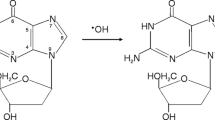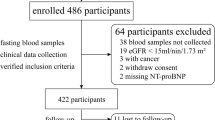Abstract
The aim of the present study was to determine whether urinary 8-hydroxydeoxyguanosine (8-OHdG), which is a marker of oxidative stress, can predict future cardiovascular death in patients with acute coronary syndrome (ACS). A total of 551 consecutive patients with ACS who underwent admission urinary 8-OHdG measurements were enrolled in this study. The patients were divided into 2 groups according to the optimal cutoff value of admission urinary 8-OHdG determined by a receiver-operating characteristics curve for the prediction of cardiovascular death: a high admission urinary 8-OHdG group, 169 patients with admission urinary 8-OHdG ≥ 17.92 ng/mg creatinine; and a low admission urinary 8-OHdG group, 382 patients with admission urinary 8-OHdG < 17.92 ng/mg creatinine. The patients were followed up for a median period of 34 months. The primary and secondary end points were the incidence of cardiovascular death and major cardiovascular events (MACE) composed of cardiovascular death, non-fatal myocardial infarction, or urgent hospitalization for heart failure. Of the 551 patients, cardiovascular deaths and MACE occurred in 14 (2.5%) and 35 (6.4%), respectively. The Kaplan–Meier estimate of the event-free rate revealed cardiovascular deaths and MACE were more likely in the high admission 8-OHdG group than in the low admission 8-OHdG group (log rank, both P < 0.001). Multiple adjusted Cox proportional hazards analysis indicated that high admission urinary 8-OHdG was an independent predictor of cardiovascular death (hazard ratio [HR] 7.642, P = 0.011) and MACE (HR 2.153, P = 0.049). High admission urinary 8-OHdG levels predict cardiovascular mortality after adjustment in patients with ACS.



Similar content being viewed by others
References
Forstermann U, Xia N, Li H (2017) Roles of vascular oxidative stress and nitric oxide in the pathogenesis of atherosclerosis. Circ Res 120:713–735
Palmer RM, Ferrige AG, Moncada S (1987) Nitric oxide release accounts for the biological activity of endothelium-derived relaxing factor. Nature 327:524–526
Kawasaki T, Dewerchin M, Lijnen HR, Vermylen J, Hoylaerts MF (2000) Vascular release of plasminogen activator inhibitor-1 impairs fibrinolysis during acute arterial thrombosis in mice. Blood 96:153–160
Meng H, Tonnesen MG, Marchese MJ, Clark RA, Bahou WF, Gruber BL (1995) Mast cells are potent regulators of endothelial cell adhesion molecule icam-1 and vcam-1 expression. J Cell Physiol 165:40–53
Rajagopalan S, Meng XP, Ramasamy S, Harrison DG, Galis ZS (1996) Reactive oxygen species produced by macrophage-derived foam cells regulate the activity of vascular matrix metalloproteinases in vitro. Implications for atherosclerotic plaque stability. J Clin Investig 98:2572–2579
Peoples JN, Saraf A, Ghazal N, Pham TT, Kwong JQ (2019) Mitochondrial dysfunction and oxidative stress in heart disease. Exp Mol Med 51:162
Heitzer T, Schlinzig T, Krohn K, Meinertz T, Munzel T (2001) Endothelial dysfunction, oxidative stress, and risk of cardiovascular events in patients with coronary artery disease. Circulation 104:2673–2678
Baldus S, Heeschen C, Meinertz T, Zeiher AM, Eiserich JP, Munzel T, Simoons ML, Hamm CW (2003) Myeloperoxidase serum levels predict risk in patients with acute coronary syndromes. Circulation 108:1440–1445
Mocatta TJ, Pilbrow AP, Cameron VA, Senthilmohan R, Frampton CM, Richards AM, Winterbourn CC (2007) Plasma concentrations of myeloperoxidase predict mortality after myocardial infarction. J Am Coll Cardiol 49:1993–2000
LeLeiko RM, Vaccari CS, Sola S, Merchant N, Nagamia SH, Thoenes M, Khan BV (2009) Usefulness of elevations in serum choline and free f2)-isoprostane to predict 30-day cardiovascular outcomes in patients with acute coronary syndrome. Am J Cardiol 104:638–643
Masaki N, Sato A, Horii S, Kimura T, Toya T, Yasuda R, Namba T, Yada H, Kawamura A, Adachi T (2016) Usefulness of the d-roms test for prediction of cardiovascular events. Int J Cardiol 222:226–232
Kasai H, Crain PF, Kuchino Y, Nishimura S, Ootsuyama A, Tanooka H (1986) Formation of 8-hydroxyguanine moiety in cellular DNA by agents producing oxygen radicals and evidence for its repair. Carcinogenesis 7:1849–1851
Saito S, Yamauchi H, Hasui Y, Kurashige J, Ochi H, Yoshida K (2000) Quantitative determination of urinary 8-hydroxydeoxyguanosine (8-oh-dg) by using elisa. Res Commun Mol Pathol Pharmacol 107:39–44
Thygesen K, Alpert JS, Jaffe AS, Chaitman BR, Bax JJ, Morrow DA, White HD (2018) Fourth universal definition of myocardial infarction (2018). J Am Coll Cardiol 72:2231–2264
Kirigaya J, Iwahashi N, Tahakashi H, Minamimoto Y, Gohbara M, Abe T, Akiyama E, Okada K, Matsuzawa Y, Maejima N, Hibi K, Kosuge M, Ebina T, Tamura K, Kimura K (2019) Impact of cardio-ankle vascular index on long-term outcome in patients with acute coronary syndrome. J Atheroscler Thromb. https://doi.org/10.5551/jat.51409
Kanda Y (2013) Investigation of the freely available easy-to-use software ‘ezr’ for medical statistics. Bone Marrow Transplant 48:452–458
Roest M, Voorbij HA, Van der Schouw YT, Peeters PH, Teerlink T, Scheffer PG (2008) High levels of urinary f2-isoprostanes predict cardiovascular mortality in postmenopausal women. J Clin Lipidol 2:298–303
Otsuka K, Shimada K, Katayama H, Nakamura H, Ishikawa H, Takeda H, Fujimoto K, Kasayuki N, Yoshiyama M (2019) Prognostic significance of renal dysfunction and its change pattern on outcomes in patients with acute coronary syndrome treated with emergent percutaneous coronary intervention. Heart Vessels 34:735–744
Morrow DA, Rifai N, Antman EM, Weiner DL, McCabe CH, Cannon CP, Braunwald E (1998) C-reactive protein is a potent predictor of mortality independently of and in combination with troponin t in acute coronary syndromes: a timi 11a substudy. Thrombolysis in myocardial infarction. J Am Coll Cardiol 31:1460–1465
Alexander JH, Sparapani RA, Mahaffey KW, Deckers JW, Newby LK, Ohman EM, Corbalan R, Chierchia SL, Boland JB, Simoons ML, Califf RM, Topol EJ, Harrington RA (2000) Association between minor elevations of creatine kinase-mb level and mortality in patients with acute coronary syndromes without st-segment elevation. Pursuit steering committee. Platelet glycoprotein iib/iiia in unstable angina: receptor suppression using integrilin therapy. JAMA 283:347–353
de Lemos JA, Morrow DA, Bentley JH, Omland T, Sabatine MS, McCabe CH, Hall C, Cannon CP, Braunwald E (2001) The prognostic value of b-type natriuretic peptide in patients with acute coronary syndromes. N Engl J Med 345:1014–1021
Ide T, Tsutsui H, Hayashidani S, Kang D, Suematsu N, Nakamura K, Utsumi H, Hamasaki N, Takeshita A (2001) Mitochondrial DNA damage and dysfunction associated with oxidative stress in failing hearts after myocardial infarction. Circ Res 88:529–535
Kobayashi S, Susa T, Tanaka T, Wada Y, Okuda S, Doi M, Nao T, Yoshiga Y, Yamada J, Okamura T, Ueyama T, Kawamura S, Yano M, Matsuzaki M (2011) Urinary 8-hydroxy-2′-deoxyguanosine reflects symptomatic status and severity of systolic dysfunction in patients with chronic heart failure. Eur J Heart Fail 13:29–36
Kasahara S, Sakata Y, Nochioka K, Yamauchi T, Onose T, Tsuji K, Abe R, Oikawa T, Sato M, Aoyanagi H, Miura M, Shiroto T, Takahashi J, Miyata S, Shimokawa H (2018) Comparable prognostic impact of bnp levels among hfpef, borderline hfpef and hfref: a report from the chart-2 study. Heart Vessels 33:997–1007
Nagayoshi Y, Kawano H, Hokamaki J, Miyamoto S, Kojima S, Shimomura H, Tsujita K, Sakamoto T, Yoshimura M, Ogawa H (2005) Urinary 8-hydroxy-2′-deoxyguanosine levels increase after reperfusion in acute myocardial infarction and may predict subsequent cardiac events. Am J Cardiol 95:514–517
Di Minno A, Turnu L, Porro B, Squellerio I, Cavalca V, Tremoli E, Di Minno MN (2017) 8-hydroxy-2-deoxyguanosine levels and heart failure: a systematic review and meta-analysis of the literature. Nutr Metab Cardiovasc Dis 27:201–208
Acknowledgments
Funding was provided by Astellas, Astra Zeneca, Boehringer Ingelheim, Daiichi Sankyo, Eisai, Kowa, Kyowa Hakko Kirin, Merck, Mitsubishi Tanabe, Ono, Otsuka, Pfizer, Sanofi Aventis, Shionogi, Sumitomo Dainippon, Takeda, and Terumo.
Author information
Authors and Affiliations
Corresponding author
Ethics declarations
Conflict of interest
Dr. Kimura reports receiving research grant support from Astellas, Astra Zeneca, Boehringer Ingelheim, Daiichi Sankyo, Eisai, Kowa, Kyowa Hakko Kirin, Merck, Mitsubishi Tanabe, Ono, Otsuka, Pfizer, Sanofi Aventis, Shionogi, Sumitomo Dainippon, Takeda, and Terumo.
Additional information
Publisher's Note
Springer Nature remains neutral with regard to jurisdictional claims in published maps and institutional affiliations.
Rights and permissions
About this article
Cite this article
Gohbara, M., Iwahashi, N., Nakahashi, H. et al. Clinical impact of admission urinary 8-hydroxydeoxyguanosine level for predicting cardiovascular mortality in patients with acute coronary syndrome. Heart Vessels 36, 38–47 (2021). https://doi.org/10.1007/s00380-020-01663-4
Received:
Accepted:
Published:
Issue Date:
DOI: https://doi.org/10.1007/s00380-020-01663-4




